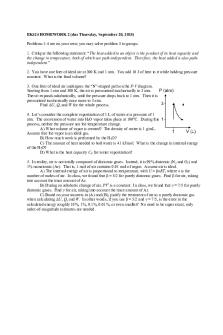EK424 HW2+solutions - Fall 2018 PDF

| Title | EK424 HW2+solutions - Fall 2018 |
|---|---|
| Course | Thermodynamics and Statistical Mechanics |
| Institution | Boston University |
| Pages | 6 |
| File Size | 706.7 KB |
| File Type | |
| Total Downloads | 3 |
| Total Views | 135 |
Summary
Fall 2018...
Description
EK424 HOMEWORK 2 (due Thursday, September 20, 2018) Problems 1-4 are on your own; you may solve problem 5 in groups. 1. Critique the following statement: “The heat added to an object is the product of its heat capacity and the change in temperature, both of which are path-independent. Therefore, the heat added is also pathindependent.” 2. You have one liter of ideal air at 300 K and 1 atm. You add 10 J of heat to it while holding pressure constant. What is the final volume? 3. One liter of ideal air undergoes the “N”-shaped path on the P-V diagram. Starting from 1 atm and 300 K, the air is pressurized isochorically to 3 atm. Then it expands adiabatically, until the pressure drops back to 1 atm. Then it is pressurized isochorically once more to 3 atm. Find ΔU, Q, and W for the whole process. 4. Let’s consider the complete vaporization of 1 L of water at a pressure of 1 atm. The conversion of water into H2O vapor takes place at 100°C. During this process, neither the pressure nor the temperature change. A) What volume of vapor is created? The density of water is 1 g/mL. Assume that the vapor is an ideal gas. B) How much work is performed by the H2O? C) The amount of heat needed to boil water is 41 kJ/mol. What is the change in internal energy of the H2O? D) What is the heat capacity CP for water vaporization? 5. In reality, air is not totally composed of diatomic gases. Instead, it is 99% diatomic (N2 and O2) and 1% monatomic (Ar). That is, 1 mol of air contains 0.01 mol of argon. Assume air is ideal. A) The internal energy of air is proportional to temperature, with U = βnRT, where n is the number of moles of air. In class, we found that β = 5/2 for purely diatomic gases. Find β for air, taking into account the trace amount of Ar. B) During an adiabatic change of air, PVγ is a constant. In class, we found that γ = 7/5 for purely diatomic gases. Find γ for air, taking into account the trace amount of Ar. C) Based on your answers in (A) and (B), justify the treatment of air as a purely diatomic gas when calculating ΔU, Q, and W. In other words, if you use β = 5/2 and γ = 7/5, is the error in the calculated energy roughly 10%, 1%, 0.1%, 0.01%, or even smaller? No need to be super exact, only order-of-magnitude estimates are needed....
Similar Free PDFs

EK424 HW2+solutions - Fall 2018
- 6 Pages

EK424 HW1+solutions - Fall 2018
- 4 Pages

FYF Syllabus Fall 2018
- 8 Pages

CES 3102 Fall 2018
- 4 Pages

Syllabus fall 2018
- 8 Pages

Syllabus 2018 fall-3
- 3 Pages

Psyc330 Fall 2018
- 7 Pages

PSYC2900 Fall 2018 Syllabus
- 5 Pages

Clinical IPR - Fall 2018
- 1 Pages

A10 - webwork fall 2018
- 15 Pages

CQMS102courseoutline Fall 2018
- 10 Pages

KIN 1352 Fall 2018 Syllabus
- 6 Pages

GB 307 Syllabus Fall 2018
- 5 Pages

NRSG 115 Syllabus - Fall 2018
- 21 Pages
Popular Institutions
- Tinajero National High School - Annex
- Politeknik Caltex Riau
- Yokohama City University
- SGT University
- University of Al-Qadisiyah
- Divine Word College of Vigan
- Techniek College Rotterdam
- Universidade de Santiago
- Universiti Teknologi MARA Cawangan Johor Kampus Pasir Gudang
- Poltekkes Kemenkes Yogyakarta
- Baguio City National High School
- Colegio san marcos
- preparatoria uno
- Centro de Bachillerato Tecnológico Industrial y de Servicios No. 107
- Dalian Maritime University
- Quang Trung Secondary School
- Colegio Tecnológico en Informática
- Corporación Regional de Educación Superior
- Grupo CEDVA
- Dar Al Uloom University
- Centro de Estudios Preuniversitarios de la Universidad Nacional de Ingeniería
- 上智大学
- Aakash International School, Nuna Majara
- San Felipe Neri Catholic School
- Kang Chiao International School - New Taipei City
- Misamis Occidental National High School
- Institución Educativa Escuela Normal Juan Ladrilleros
- Kolehiyo ng Pantukan
- Batanes State College
- Instituto Continental
- Sekolah Menengah Kejuruan Kesehatan Kaltara (Tarakan)
- Colegio de La Inmaculada Concepcion - Cebu

